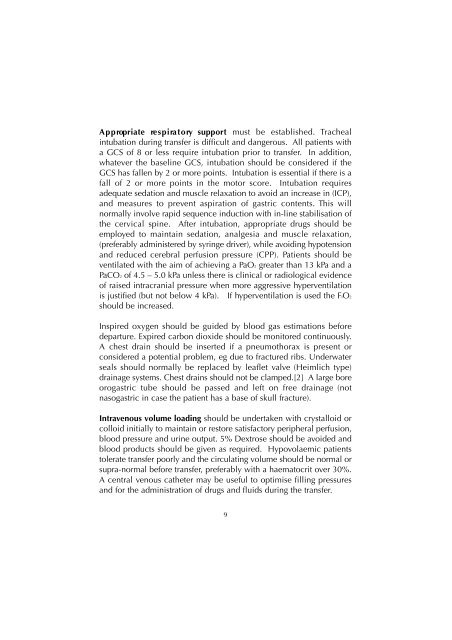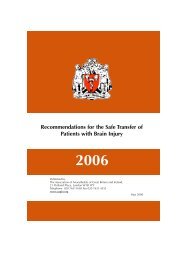TheatrePracticeStandardsGeneric1
You also want an ePaper? Increase the reach of your titles
YUMPU automatically turns print PDFs into web optimized ePapers that Google loves.
A p p ropriate re s p i ra t o ry support must be established. Tra ch e a l<br />
intubation during transfer is difficult and dangerous. All patients with<br />
a GCS of 8 or less require intubation prior to transfer. In addition,<br />
whatever the baseline GCS, intubation should be considered if the<br />
GCS has fallen by 2 or more points. Intubation is essential if there is a<br />
fall of 2 or more points in the motor score. Intubation requires<br />
adequate sedation and muscle relaxation to avoid an increase in (ICP),<br />
and measures to prevent aspiration of gastric contents. This will<br />
normally involve rapid sequence induction with in-line stabilisation of<br />
the cervical spine. After intubation, appropriate drugs should be<br />
employed to maintain sedation, analgesia and muscle relaxation,<br />
(preferably administered by syringe driver), while avoiding hypotension<br />
and reduced cerebral perfusion pressure (CPP). Patients should be<br />
ventilated with the aim of achieving a PaO2 greater than 13 kPa and a<br />
PaCO2 of 4.5 – 5.0 kPa unless there is clinical or radiological evidence<br />
of raised intracranial pressure when more aggressive hyperventilation<br />
is justified (but not below 4 kPa). If hyperventilation is used the FIO2<br />
should be increased.<br />
Inspired oxygen should be guided by blood gas estimations before<br />
departure. Expired carbon dioxide should be monitored continuously.<br />
A chest drain should be inserted if a pneumothorax is present or<br />
considered a potential problem, eg due to fractured ribs. Underwater<br />
seals should normally be replaced by leaflet valve (Heimlich type)<br />
drainage systems. Chest drains should not be clamped.[2] A large bore<br />
orogastric tube should be passed and left on free drainage (not<br />
nasogastric in case the patient has a base of skull fracture).<br />
Intravenous volume loading should be undertaken with crystalloid or<br />
colloid initially to maintain or restore satisfactory peripheral perfusion,<br />
blood pressure and urine output. 5% Dextrose should be avoided and<br />
blood products should be given as required. Hypovolaemic patients<br />
tolerate transfer poorly and the circulating volume should be normal or<br />
supra-normal before transfer, preferably with a haematocrit over 30%.<br />
A central venous catheter may be useful to optimise filling pressures<br />
and for the administration of drugs and fluids during the transfer.<br />
9





